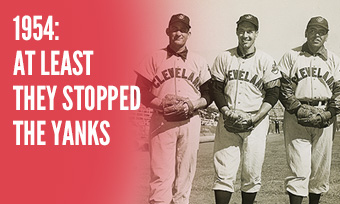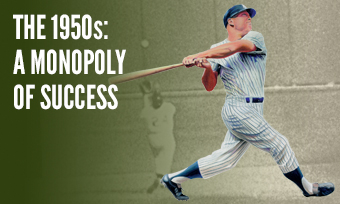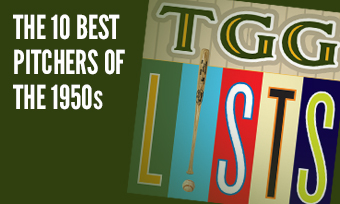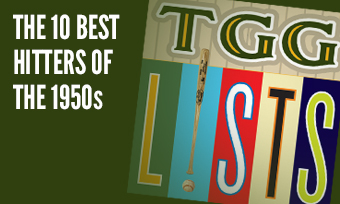The Yearly Reader
Leaders and Honors, 1954
Our list of baseball’s top 10 hitters and pitchers in both the American League and National League for the 1954 baseball season, as well as the awards and honors given to the game’s top achievers of the year.
The National League’s Top 10 Hitters, 1954
Bold type in brick red indicates league leader.
1. Duke Snider, Brooklyn
Key Numbers: .341 average, 120 runs, 199 hits, 39 doubles, 10 triples, 40 home runs, 130 RBIs, 84 walks, 96 strikeouts.
Whether it was because he stung lefties more, was protected by a gang of right-handed slugging stars, or that he was just simply getting better, Snider emerged into a monster force with the first of five straight years with 40-plus homers.
2. Willie Mays, New York
Key Numbers: .345 average, 119 runs, 195 hits, 33 doubles, 13 triples, 41 home runs, 110 RBIs, 66 walks, .667 slugging percentage.
Mays’ 41 homers reminded many in later years that had it not been for the loss of the previous two seasons to the military, he likely would have surpassed 700 for his career and challenged Babe Ruth’s then-record.
3. Ted Kluszewski, Cincinnati
Key Numbers: .326 average, 104 runs, 187 hits, 28 doubles, 49 home runs, 141 RBIs, 78 walks.
Of Kluszewski’s league-leading 49 homers, 34 of them came at home—a NL record until Mark McGwire in 1998.
4. Stan Musial, St. Louis
Key Numbers: .330 average, 120 runs, 195 hits, 41 doubles, 9 triples, 35 home runs, 126 RBIs, 103 walks, 27 intentional walks.
Musial tallied 100-plus runs for the 11th straight year; he would never surpass it again in any of his remaining nine seasons.
5. Eddie Mathews, Milwaukee
Key Numbers: .290 average, 96 runs, 35 home runs, 126 RBIs, 103 walks.
After a modest start, Mathews hit .329 with 26 home runs over his final 75 games.
6. Gil Hodges, Brooklyn
Key Numbers: 154 games, .304 average, 106 runs, 176 hits, 23 doubles, 5 triples, 42 home runs, 130 RBIs, 74 walks, 19 sacrifice flies.
Nineteen of Gil Hodges’ RBIs came thanks to a still-record dose (19) of sacrifice flies—the first year they were officially counted as a statistic.
7. Hank Sauer, Chicago
Key Numbers: .288 average, 98 runs, 41 home runs, 103 RBIs, 70 walks.
The aging (37) slugger flashed vintage muscle, setting a career high in home runs while becoming one of a then-record six National Leaguers to hit at least 40; 13 of his clouts came against the Pirates alone.
8. Wally Moon, St. Louis
Key Numbers: .304 average, 106 runs, 193 hits, 29 doubles, 9 triples, 12 home runs, 76 RBIs, 71 walks, 18 stolen bases.
Solid start for the NL Rookie of the Year, setting personal bests in runs, hits, doubles and steals; not that any of his ensuing years would be all that much worse.
9. Gus Bell, Cincinnati
Key Numbers: .299 average, 104 runs, 185 hits, 38 doubles, 7 triples, 17 home runs, 101 RBIs.
Bell suffered a power outage on the road but hit 15 of his 17 homers at Crosley Field, newly shrunk to heavily favor hitters.
10. Hank Thompson, New York
Key Numbers: .263 average, 28 home runs, 86 RBIs, 90 walks.
In a year memorable for single-game performances—Joe Adcock’s four-homer effort and Stan Musial’s five-homer doubleheader among them—Thompson rivaled the top of the list with a three-homer, eight-RBI performance at St. Louis on June 3.
The American League’s Top 10 Hitters, 1954
1. Ted Williams, Boston
Key Numbers: 117 games, .345 average, 93 runs, 133 hits, 23 doubles, 29 home runs, 89 RBIs, 136 walks, 17 intentional walks, .513 on-base percentage, .635 slugging percentage.
A busted collarbone was no help for Williams in his quest to take his first batting title in six years, but neither were his 136 walks—which held him under the 400 at-bats needed to qualify for the title. (Under today’s rules, he would earn the crown.)
2. Minnie Minoso, Chicago
Key Numbers: .320 average, 119 runs, 182 hits, 29 doubles, 18 triples, 19 home runs, 116 RBIs, 77 walks, 16 hit-by-pitches, 18 stolen bases, 11 caught stealing.
The man who would play forever—if only he was allowed—Minoso put up some of the year’s more immortal numbers in the AL, even if they were more reflective of the Deadball Era.
3. Mickey Mantle, New York
Key Numbers: .300 average, 129 runs, 163 hits, 17 doubles, 12 triples, 27 home runs, 102 RBIs, 102 walks, 107 strikeouts.
Mantle survived two operations on his right knee during the off-season to help continue improve his numbers.
4. Larry Doby, Cleveland
Key Numbers: .272 average, 94 runs, 32 home runs, 126 RBIs, 85 walks.
Doby’s AL-best home run count didn’t include a 33rd hit at the All-Star Game in front of his home fans at Cleveland. Though he never won an MVP, he came closest in 1954, finishing a close second (230-210) to…
5. Yogi Berra, New York
Key Numbers: .307 average, 88 runs, 179 hits, 28 doubles, 6 triples, 22 home runs, 125 RBIs.
It was déjà vu all over again for Berra, who won his second of three AL MVPs.
6. Al Rosen, Cleveland
Key Numbers: .341 average, 112 runs, 189 hits, 27 doubles, 15 home runs, 67 RBIs, 19 sacrifice hits.
Even the post-injured-finger Rosen had numbers good enough to make this list, but it’s a Hall of Fame-stealing shame that he never got close to emulating his early, prodigious stats.
7. Bobby Avila, Cleveland
Key Numbers: 137 games, .296 average, 80 runs, 23 doubles, 5 triples, 27 home runs, 108 RBIs.
Rosen wasn’t the only Clevelander whose numbers suffered in the aftermath of a broken finger. Avila was hitting .384 when he fractured his thumb in early June—yet still managed to hang on to (officially) win the AL batting title.
8. Jackie Jensen, Boston
Key Numbers: .276 average, 92 runs, 25 doubles, 7 triples, 25 home runs, 117 RBIs, 79 walks, 22 stolen bases, 32 grounded into double plays, 11 sacrifice flies.
Making up: Jensen led the league in grounding into double plays, but also led in steals.
9. Mickey Vernon, Washington
Key Numbers: .290 average, 90 runs, 173 hits, 33 doubles, 14 triples, 20 home runs, 97 RBIs.
Vernon’s 33 doubles were the fewest hit by an American Leaguer leader (over a non-abbreviated season) until 1973.
10. Nellie Fox, Chicago
Key Numbers: 155 games, .319 average, 111 runs, 201 hits, 24 doubles, 8 triples, 2 home runs, 47 RBIs, 12 strikeouts, 16 stolen bases.
The light-hitting but highly revered White Sox legend had it all going in 1954, setting personal bests in bat average, runs, hits and stolen bases.
The National League’s Top 10 Pitchers, 1954
1. Johnny Antonelli, New York
Key Numbers: 2.30 ERA, 21 wins, 7 losses, .750 win percentage, 37 starts, 6 shutouts, 258.2 innings.
A big-time breakout for Antonelli, who in his first year after being traded from Milwaukee surely helped make Giants fans forget about the guy they traded to get him: 1951 pennant-winning hero Bobby Thomson.
2. Lew Burdette, Milwaukee
Key Numbers: 2.76 ERA, 15 wins, 14 losses, 38 appearances, 32 starts, 238 innings, 62 walks, 29 grounded into double plays.
The early success of Burdette—born in Nitro, West Virginia—had opponents blowing up over his alleged headhunting and use of the spitter.
3. Warren Spahn, Milwaukee
Key Numbers: 3.14 ERA, 21 wins, 12 losses, 3 saves, 39 appearances, 34 starts, 23 complete games, 283.1 innings.
Here’s part of the secret to another good year for Spahn; the Braves made sure he never started against the potent Dodgers, for whom he was 6-17 against over the previous five years.
4. Robin Roberts, Philadelphia
Key Numbers: 2.97 ERA, 23 wins, 15 losses, 4 saves, 45 appearances, 38 starts, 29 complete games, 336.2 innings, 56 walks, 185 strikeouts.
Roberts never threw a no-hitter, but he tossed three one-hitters—two of them in 1954.
5. Curt Simmons, Philadelphia
Key Numbers: 2.81 ERA, 14 wins, 15 losses, 33 starts, 21 complete games, 253 innings, 27 grounded into double plays.
Simmons did his best to emulate marquee pitching mate Roberts, hurling a career-high 21 complete games and pitching into extra innings three times.
6. Harvey Haddix, St. Louis
Key Numbers: 3.57 ERA, 18 wins, 13 losses, 4 saves, 43 appearances, 35 starts, 259.2 innings, 184 strikeouts.
The third-year pitcher was at his hottest early on, winning 12 games before the end of June—including a seven-game stretch in which he went the distance every time and furnished a 37.1-inning scoreless streak, the year’s longest in the majors.
7. Ruben Gomez, New York
Key Numbers: 2.88 ERA, 17 wins, 9 losses, 37 appearances, 32 starts, 221.2 innings, 109 walks, 14 intentional walks.
While Johnny Antonelli got much of the credit for the Giants’ big splash, not to be forgotten was #2 pitcher Ruben Gomez—wild, testy and, in 1954, as effective as ever.
8. Gene Conley, Milwaukee
Key Numbers: 2.96 ERA, 14 wins, 9 losses, 27 starts, 194.1 innings.
The 6’8” rookie pitcher was at his best before taking on a higher calling late in the decade: Playing power forward for the champion Boston Celtics in the NBA.
9. Carl Erskine, Brooklyn
Key Numbers: 4.18 ERA, 18 wins, 15 losses, 37 starts, 260.1 innings.
The hard-throwing righty was occasionally hard-hit—giving up 31 home runs and a NL-high 120 earned tallies—but still managed to lock up 18 wins.
10. Marv Grissom, New York
Key Numbers: 2.35 ERA, 10 wins, 7 losses, 19 saves, 56 appearances, 3 starts, 122.1 innings.
After bouncing about the AL, Grissom returned to the Giants (who initially brought him on in 1946) and set a then-franchise record for saves.
The American League’s Top 10 Pitchers, 1954
1. Mike Garcia, Cleveland
Key Numbers: 2.64 ERA, 19 wins, 8 losses, 5 saves, 45 appearances, 34 starts, 5 shutouts, 258.2 innings.
The burly Californian won his second ERA title in five years, something none of his more esteemed Cleveland teammates could achieve.
2. Early Wynn, Cleveland
Key Numbers: 2.73 ERA, 23 wins, 11 losses, .676 win percentage, 40 appearances, 36 starts, 20 complete games, 270.2 innings.
The man who would lead the AL in wins during the 1950s paced the league for the first time with a career high-tying 23.
3. Bob Lemon, Cleveland
Key Numbers: 2.72 ERA, 23 wins, 7 losses, .767 win percentage, 33 starts, 21 complete games, 258.1 innings, 22 grounded into double plays.
Joining Wynn at the top of the victory charts was Lemon, who also tied a career mark.
4. Virgil Trucks, Chicago
Key Numbers: 2.79 ERA, 19 wins, 12 losses, 3 saves, 40 appearances, 33 starts, 5 shutouts, 264.2 innings, 22 grounded into double plays.
The guy who threw two no-hitters just a couple of years earlier tossed two one-hitters in 1954.
5. Ned Garver, Detroit
Key Numbers: 2.81 ERA, 14 wins, 11 losses, 32 starts, 246.1 innings, 23 grounded into double plays.
The former St. Louis Browns ace, whose name seemed stolen from the 19th Century, regained fine form after a dip in quality through the previous few years.
6. Bob Grim, New York
Key Numbers: 3.26 ERA, 20 wins, 6 losses, 37 appearances, 20 starts, 199 innings, 26 grounded into double plays.
The 24-year-old rookie became the first pitcher to win 20 games in under 200 innings.
7. Sandy Consuegra, Chicago
Key Numbers: 2.69 ERA, 16 wins, 3 losses, .842 win percentage, 39 appearances, 17 starts, 154 innings, 35 walks.
A one-year wonder simply in terms of wins and losses, the Cuban-born starter/reliever maintained solid efficiency but was rewarded with an unusually high number of victories.
8. Steve Gromek, Detroit
Key Numbers: 2.74 ERA, 18 wins, 16 losses, 36 appearances, 32 starts, 252.2 innings, 12 hit-by-pitches.
After spending a decade failing to crack the stellar Cleveland rotation, Gromek got workhorse duty in Detroit and exclaimed, “It’s great to be a regular after 13 years as a rookie.”
9. Johnny Schmitz, Washington
Key Numbers: 2.91 ERA, 11 wins, 8 losses, 29 appearances, 23 starts, 185.1 innings, 29 grounded into double plays.
Six years after peaking with the Cubs, Schmitz found himself back on strong footing as one of four full-time starting lefties for the Senators—the most for any major league club until the 2013 White Sox.
10. Whitey Ford, New York
Key Numbers: 2.82 ERA, 16 wins, 8 losses, 34 appearances, 28 starts, 210.2 innings, 101 walks, 25 grounded into double plays.
Just another ho-hum year of stardom for the young southpaw, though he did overcome a rough start—posting a 2.23 ERA from May 25 on.









